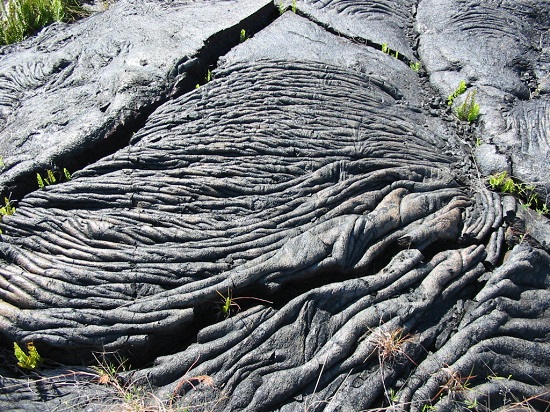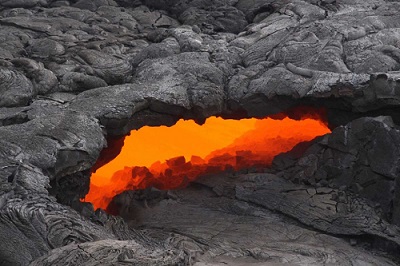What is pahoehoe lava?
Pahoehoe lava flows
Hawaiian term
Pahoehoe lava is a term used by Hawaiian to describe lava flows with a smooth unbroken surface. The basalt lava flows are typically 1100 to 1200 degrees Centigrade when they flow out of a volcano vent. They often form lava tubes that carry lava far down the slopes where they empty into the ocean at the flow front. The lava tubes become lava caves after the eruption ceases.

Pahoehoe lava flow on the Island of Hawaii, Myrna Martin
How Pahoehoe flows across the land
Pahoehoe flows
The pahoehoe flow moves down the volcano forming a series of lobes and toes. The new lava breaks through the flow front as the lava moves down the mountain. As the basalt lava flows away from the vent it forms all kinds of bizarre shapes. The rocks are often described as rock sculptures.


Click for More Information and to Order
Formation of a lava tube
Pahoehoe moving down slope
Lava tubes form during
volcanic eruptions of basalt that produce pahoehoe lava flows down the flanks
of a volcano. The lava as it makes its way down the mountain usually travels
about a half mile per hour. The movement is like water flowing down a hillside for
the first time. Lava winds around obstacles following low points in the land.
Lava moving down the volcano inside a lava tube
The edges of the lava flow cools and crusts over as it
encounters older rocks forming a lava tube. Sealed inside the smooth sides of a
lava tube the molten rock can travel miles to the flow front with very little
cooling and at a much greater speed. Geologists believe lava reaches speeds of 23 miles per hour in some
lava tubes.
Lava meandering down a slope
Lava flows form channels
Pahoehoe lava flowing from a
crater on the summit of a volcano will form channels as the outside edges of
the flow cool. The channels are like rivers with riverbanks. Often the channels
will meander down the side of the mountain seeking the lowest point.

Skylight on Kilauea USGS
Skylights in lava tubes
More than one channel for a lava flow
The lava flow can split and have more than one channel as it
flows downhill. New eruptions cause lava to overflow the channels causing its
sides to become taller and wider. The outside edges of the flow crust over
forming a roof over the channel as the eruption continues.
Formation of a skylight
If the roof of the lava tube is weak, parts of it may
fall into the lava flow and be carried away creating a skylight. After the
eruption ceases the roof will continue to cool and contract sometimes creating
new skylights. Skylights are often used as entrances to underground lava caves.
lavacicles & lava stalagmites
Lavacicles in lava tube
Lava tubes create a variety of formations that are similar
to ones found in limestone caverns. Lavacicles are formations resembling
icicles. They are round tipped and usually about a half-inch long. Some
lavacicles grow more than 30 inches long. They form in lava tubes when lava
froth drips off the ceiling forming a small blunt pyramid of rock.
Shark tooth stalactites, splash stalactites and soda straws are some of the names given different types of lavacicles. Lava stalagmites form when droplets of lava fall on the same spot beneath a lavacicle.
Pahoehoe becomes an aa lava flow
Pahoehoe flow becomes aa lava flow
Cooling pahoehoe flows sometimes turn into aa lava flows. Aa lava flows never become pahoehoe flows. Aa flows are cooler and move at a much slower speed. People can sometimes walk in front of aa lava flow taking pictures as it moves forward.
KIDS FUN Science Bookstore
Check out Myrna Martin's award winning textbooks, e-books, videos and rock sets. The Kids Fun Science Bookstore covers a wide range of earth science topics. Click here to browse.










